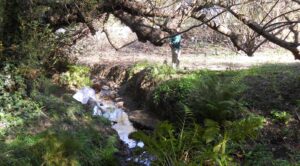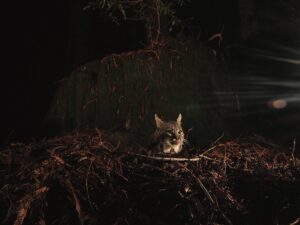As the slanted light of morning streams into the large clearing where Peter Ehrlich and his forestry crew work, it glints off a pickup truck filled with rows of bright green seedlings like tiny soldiers at attention. The young trees, lined up for planting, are dwarfed by the backdrop of towering eucalyptus, Monterey pine, and Monterey cypress planted here in San Francisco’s Presidio by the U.S. Army more than 120 years ago, but the crew’s intention for them is lofty: to replace a dying forest.
“We keep the [old trees] as long as we can, but some are too far gone,” says Ehrlich, lead forester for the Presidio Trust. For the past 10 years he and his crew have been undertaking an ambitious project to rejuvenate all 300 acres of the Presidio’s forest by removing and replanting aging stands of trees. Ehrlich’s job is complicated: these aging trees aren’t just wildlife habitat, they’re cultural artifacts from a place with a long human history.
Before the first pine tree loomed over these hills, the Presidio de San Francisco was the northernmost outpost of Spain. Looking out along the high western ridge the vista would have unfolded in rolling waves of sand and grass, dotted with scrubby plants that unfurled all the way to the sea. A few oaks lined the creek beds, and everything was bent to the wind and salt air.
“It would have looked a lot like the Marin headlands,” with grasslands on the east side and dunes of ancient sand that blew up here 10,000 years ago, Ehrlich says. But when the Army moved in in 1846, it didn’t find these sands of time so much poetic as unpleasant. “They were very uncomfortable,” Ehrlich says. “They had to put lattices on the street to block the wind from blowing sand everywhere, and officers with living rooms on the windward side had sand filling them.”
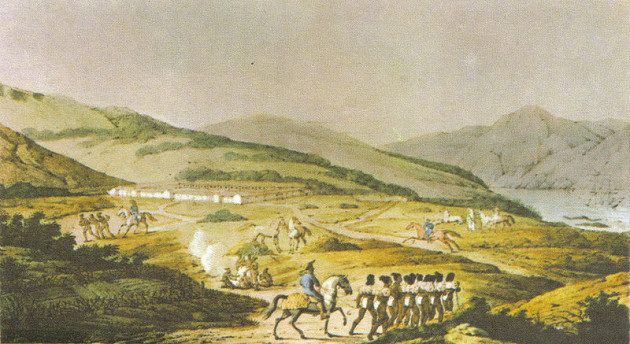
The native oaks that grew in the area were too short to serve as protection from the wind and sand, and the dune habitat looked nothing like the forests that Easterners knew and loved. And after the dunes of Golden Gate Park were forested in the 1880s, confidence mounted that the same transformation could take place at the Presidio. Major William Jones conceived of the project in his Plan For the Cultivation of Trees Upon the Presidio Reservation, a vision encompassing the practical need for a windbreak as well as the desire to highlight the power of government using dense, towering stands of trees.
Soldiers provided ample cheap labor to get the job done fast, and by 1910, 100,000 Monterey pine, Monterey cypress, and eucalyptus trees covered the ridgetops and gateways of the Presidio. Although many subsequently died from being planted too close together, 60,000 trees survived.
By the time the Army left and the Presidio became a park in 1994, the shorter-lived cypress and pines were all reaching the end of their lifespans. In 2001 the Presidio Trust and the National Park Service came up with a plan for the Presidio that included managing the forest for the future.
“The idea is to plant in different spots and smaller plots, to get a better age structure and an uneven-age forest,” Ehrlich says. By reforesting in small blocks, and spacing the interval between plantings — rather than all at once like it was originally planted — the foresters hope to create a more natural forest, with trees in different stages of growth and decline.
Ehrlich and his team have removed and replaced roughly two and a half acres of aging trees each year since 2003. Though they still have a long way to go — he estimates it will take about 65 years to get through all the conifers planted by the Army — in 10 years they have successfully planted 3,700 trees.
Some trees have even been optimized for their new role. The Presidio Trust and researchers at UC Davis developed Monterey pines that are resistant to pine pitch canker, a deadly fungal disease that has ravaged many trees in the area. Their success can be seen around the World War II Memorial, where resistant pines planted several years ago have been thriving.
Although the team is primarily focused on reforesting conifers, it’s impossible to overlook the one truly nonnative tree in the area: the Tasmanian blue gum eucalyptus that makes up nearly 50 percent of the historic forest. They’re the tallest, most effective windbreak trees in the Presidio, and at 300 years, the longest-lived. But their success also comes with a downside.
“I hate to say this about a tree, but they are too successful,” Erhlich says. Throughout the state, Tasmanian blue gum is widely considered an invasive species due to its ability to grow and reproduce rapidly, displacing plants growing around it. But the landmark status of the forest means that if any blue gum trees are removed they must be replaced with more eucalyptus. To get around this restriction, Ehrlich is currently growing test groves of eucalyptus species with fewer of these troublesome traits, such as mountain gum and spotted gum, as possible alternatives for the park.
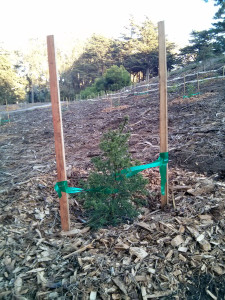
The plot he and his crew are working on today — over half an acre of Monterey cypress and eucalyptus seedlings — is one of the biggest they have undertaken so far. “The hardhat work is done,” Ehrlich says, pointing to the giant piles of downed trees surrounding the clearing. It took the forestry crew about three weeks to remove all the old trees here, their strategy shaped by the one constant in this area: wind. They are careful to angle the removal plots perpendicular to the westerly bluster, and never open up much more than half an acre at a time, or the wind could funnel through the surrounding trees and damage them. And success is especially important up here on the western ridge, where the windbreak the forest provides protects the landscaped gardens and public spaces down at the main post.
Getting seedlings to survive in this environment is a team effort. Today the landscaping crew is helping to install the drip irrigation system that will nurture the young plants for the first four years or their life. The soil, a combination of drifting sand and serpentinite, the blue-green state rock that sidewinds its way along coastal bluffs, make a harsh environment for any plant that hasn’t adapted to this place. But amending the soil with wood chips made from recycled trees helps it hold on to precious water and nutrients.
And so far the project has been a success. Cypresses planted just a few years ago near the Arguello Gate now rise 30 feet high. Like sentinels, they preside over the Presidio, but also coexist with the original settlers of this area: native plants.
From California poppies to critically endangered species such as the Franciscan manzanita, native plants cover 400 acres of serpentine bluffs and grasslands in the Presidio. They even have their own crew and management criteria, and Ehrlich says that there is sometimes tension on the borders between the native and forest zones. Often, trees must be removed to increase sunlight for native plants, as they were for the endangered Presidio clarkia. In addition, Monterey pines are a fire-adapted conifer whose seeds sometimes shoot into the native forest zones when their closed cones pop on hot summer days.
But the forest has also increased habitat for native species of birds that wouldn’t normally be able to nest here, such as great-horned owls, red-tailed hawks, and downy woodpeckers, says Ehrlich. The height diversity in the canopy has also led to a diversification in the birds, which occupy the many levels of the forest. Even bluebirds are making a comeback, he says, over the cheerful morning exhalations of pygmy nuthatches and yellow-rumped warblers that can be heard filtering through the trees.
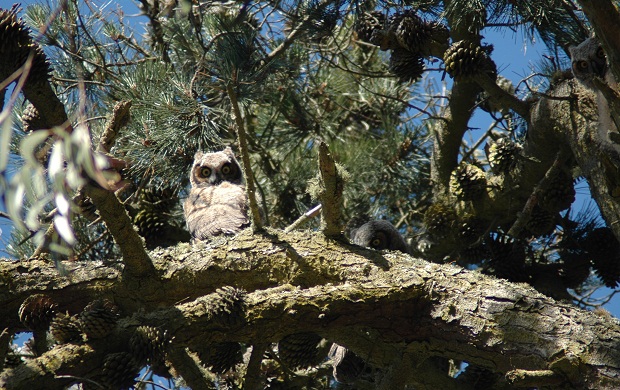
And soon the borders between native habitat and historic forest may not be so distinct. Lew Stringer, a restoration ecologist for the Presidio Trust, says that even the forest can help harbor natives. “Over the next five years we are working to diversify and infuse the understory of the forest with native plants,” Stringer says.
The first step will be unleashing a herd of goats in the area to mow down the thick blanket of English ivy that covers the ground and bases of trees. If that works, they will be able to plant natives such as coast live oak, buckeye, wildflowers, and shrubs such as the fragrant coast lilac. Toyon, also known as Christmas berry, will provide habitat for nesting birds, as well as berries, and seeds. “It’s an exciting and novel idea in urban forestry,” Stringer says.
But in a place so rooted in history, a novel approach isn’t necessarily what everyone is looking for, and visions for the future of the land can be competitive. What’s the character of the Presidio forest now? And what should it be in the future? Ehrlich says finding the answer means compromise. “As a forester I’d rather have healthy trees than preserve the look,” he says. “But it’s a balancing act, and we are walking on tightropes so nobody gets upset with us.”
Trees that need to be removed for their risk to the residents, businesses, and visitors to the area often find new life elsewhere in the Presidio: some become wood chips or benches, and some are recycled into organic installations by artist Andy Goldsworthy. His first installation, Spire, took 37 cypress logs to complete and rises to more than 90 feet near the Arguello Gate. As time marches onward it will eventually disappear into the young cypress forest growing around it. His second piece, Woodline, was made using downed eucalyptus branches laid end to end. It flows like a river through a historic eucalyptus grove near the Presidio’s oldest footpath, Lover’s Lane. Goldsworthy’s inspiration comes from the subtle shifts of place and time, fitting for a place where people and the environment are constantly influencing each other, and the human-altered landscape coexists with the wild.




